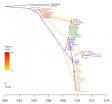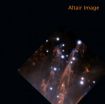(Press-News.org) WASHINGTON –A recently published paper by two George Washington University researchers shows that the running foot strike patterns vary among habitually barefoot people in Kenya due to speed and other factors such as running habits and the hardness of the ground. These results are counter to the belief that barefoot people prefer one specific style of running.
Kevin Hatala, a Ph.D. student in the Hominid Paleobiology doctoral program at George Washington, is the lead author of the paper that appears in the recent edition of the journal Public Library of Science, or PLOS ONE. In their study, Mr. Hatala along with Brian Richmond, associate professor of anthropology within GW's Columbian College of Arts and Sciences, contradict the idea that all habitually barefoot people run by landing on their forefoot first in order to avoid the high impact forces typically associated with a heel strike. This idea has become widely cited in popular running journals and has helped fuel the barefoot running movement now popular among recreational runners. However, previous research supporting this hypothesis was limited to only one population of habitually barefoot people.
Mr. Hatala, Dr. Richmond and their colleagues studied the Daasanach, a modern habitually barefoot population from northwestern Kenya, to support their theory. Data was collected from 38 adults as they ran along a track with a plantar pressure pad placed midway along its length. The subjects ran at self-selected endurance running and sprinting speeds. The collected data supported the theory that a forefoot strike reduces the magnitude of impact forces on the feet, but the majority of Daasanach subjects opted instead to use a rearfoot strike at endurance speeds.
"The Daasanach people grow up without shoes and continue to spend most of their lives barefoot," said Mr. Hatala. "We were surprised to see that the majority of Daasanach people ran by landing on their heels first and few landed on their forefoot. This contradicts the hypothesis that a forefoot strike characterizes the 'typical' running gait of habitually barefoot people."
Some Daasanach individuals switched to a forefoot strike when running at high speeds but a forefoot strike was not the typical foot strike pattern at any speed.
The analysis of running gaits within the Daasanach is only the second study of its kind and its results differed significantly from those of earlier research, which had suggested that, when running at endurance speeds, habitually barefoot people tend to land on their forefeet instead of their heels. Given that humans were barefoot for millions of years during which our foot evolved its current shape, the research also has implications for hypotheses regarding the running gaits that would have been used by our ancestors.
Mr. Hatala said the results of the study suggest that running speed, alongside other factors such as the firmness of the running surface, may have similarly influenced variation in the running gaits of early man, rather than one gait being preferred in all circumstances.
"The challenge ahead is to identify the most important factors that influence how barefoot people run and the healthiest style for today's runners," said Dr. Richmond, a co-author of the research.
###
PLOS ONE is an international, peer-reviewed, open-access, online publication and is published by PLOS, a nonprofit organization.
The Columbian College
Established in 1821 in the heart of the nation's capital, the George Washington University Columbian College of Arts and Sciences is the largest of GW's academic units. It encompasses the School of Media and Public Affairs, the Trachtenberg School of Public Policy and Public Administration and more than 40 departments and programs for undergraduate, graduate and professional studies. The Columbian College provides the foundation for GW's commitment to the liberal arts and a broad education for all students. An internationally recognized faculty and active partnerships with prestigious research institutions place Columbian College at the forefront in advancing policy, enhancing culture and transforming lives through research and discovery.
George Washington University
In the heart of the nation's capital with additional programs in Virginia, the George Washington University was created by an Act of Congress in 1821. Today, GW is the largest institution of higher education in the District of Columbia. The university offers comprehensive programs of undergraduate and graduate liberal arts study, as well as degree programs in medicine, public health, law, engineering, education, business and international affairs. Each year, GW enrolls a diverse population of undergraduate, graduate and professional students from all 50 states, the District of Columbia and more than 130 countries.
- GW -
GW researchers find variation in foot strike patterns in predominantly barefoot runners
Findings contradict what is considered the 'typical' running gait of commonly barefoot people
2013-01-10
ELSE PRESS RELEASES FROM THIS DATE:
A history lesson from genes
2013-01-10
When Charles Darwin first sketched how species evolved by natural selection, he drew what looked like a tree. The diagram started at a central point with a common ancestor, then the lines spread apart as organisms evolved and separated into distinct species.
In the 175 years since, scientists have come to agree that Darwin's original drawing is a bit simplistic, given that multiple species mix and interbreed in ways he didn't consider possible (though you can't fault the guy for not getting the most important scientific theory of all time exactly right the first time). ...
Study examines how news spreads on Twitter
2013-01-10
Nearly every major news organization has a Twitter account these days, but just how effective is the microblogging website at spreading news? That's the question University of Arizona professor Sudha Ram set out to answer in a recent study of a dozen major news organizations that use the social media website as one tool for sharing their content.
The answer, according to Ram's research, varies widely by news agency, and there may not be one universally applicable strategy for maximizing Twitter effectiveness. However, news agencies can learn a lot by looking at how their ...
Unnecessary antimicrobial use increases risk of recurrent infectious diarrhea
2013-01-10
The impact of antibiotic misuse has far-reaching consequences in healthcare, including reduced efficacy of the drugs, increased prevalence of drug-resistant organisms, and increased risk of deadly infections. A new study featured in the February issue of Infection Control and Hospital Epidemiology, the journal of the Society for Healthcare Epidemiology of America, found that many patients with Clostridium difficile infection (C. difficile) are prescribed unnecessary antibiotics, increasing their risk of recurrence of the deadly infection. The retrospective report shows ...
Flooding preparedness needs to include infection prevention and control strategies
2013-01-10
Flooding can cause clinical and economic damage to a healthcare facility, but reopening a facility after extensive flooding requires infection prevention and control preparedness plans to ensure a safe environment for patients and healthcare workers. In a study published in the February issue of Infection Control and Hospital Epidemiology, the journal of the Society for Healthcare Epidemiology of America, clinical investigators report key findings and recommendations related to the closure and re-opening of hospitals impacted by black-water floods. The guidance builds on ...
Faulty behavior
2013-01-10
PASADENA, Calif.—In an earthquake, ground motion is the result of waves emitted when the two sides of a fault move—or slip—rapidly past each other, with an average relative speed of about three feet per second. Not all fault segments move so quickly, however—some slip slowly, through a process called creep, and are considered to be "stable," or not capable of hosting rapid earthquake-producing slip. One common hypothesis suggests that such creeping fault behavior is persistent over time, with currently stable segments acting as barriers to fast-slipping, shake-producing ...
Next-generation adaptive optics brings remarkable details to light in stellar nursery
2013-01-10
A new image released today reveals how Gemini Observatory's most advanced adaptive optics (AO) system will help astronomers study the universe with an unprecedented level of clarity and detail by removing distortions due to the Earth's atmosphere. The photo, featuring an area on the outskirts of the famous Orion Nebula, illustrates the instrument's significant advancements over previous-generation AO systems.
"The combination of a constellation of five laser guide stars with multiple deformable mirrors allows us to expand significantly on what has previously been possible ...
Microscopic blood in urine unreliable indicator of urinary tract cancer
2013-01-10
Rochester, MN, January 9, 2013 – Microscopic amounts of blood in urine have been considered a risk factor for urinary tract malignant tumors. However, only a small proportion of patients referred for investigation are subsequently found to have cancer. A new Kaiser Permanente Southern California study published in the February Mayo Clinic Proceedings reports on the development and testing of a Hematuria Risk Index to predict cancer risk. This could potentially lead to significant reductions in the number of unnecessary evaluations.
Individuals with microscopic hematuria ...
Small price differences can make options seem more similar, easing our buying decisions
2013-01-10
Some retailers, such as Apple's iTunes, are known for using uniform pricing in an effort to simplify consumers' choices and perhaps increase their tendency to make impulse purchases. But other stores, like supermarkets, often have small price differences across product flavors and brands.
As counterintuitive as it might seem, these small price differences may actually make the options seem more similar, according to new research published in Psychological Science, a journal of the Association for Psychological Science. The research shows that adding small differences ...
Online message boards provide outlets for mothers' concerns, MU researcher says
2013-01-10
COLUMBIA, Mo. –Parenting infants and toddlers can be challenging, and for generations, mothers have turned to other moms for advice. Now, with the availability of the Internet, mothers are consulting each other using modern venues: online message boards. Research from the University of Missouri indicates online discussion boards provide safe environments for mothers to anonymously express child-rearing concerns and receive support from other moms.
"Mothers have feelings that they might be embarrassed to talk about face-to-face with someone," said Jean Ispa, professor ...
Invading species can extinguish native plants despite recent reports
2013-01-10
TORONTO, ON – Ecologists at the University of Toronto and the Swiss Federal Institute of Technology Zurich (ETH Zurich) have found that, given time, invading exotic plants will likely eliminate native plants growing in the wild despite recent reports to the contrary.
A study published in Proceedings of the National Academy of Sciences (PNAS) reports that recent statements that invasive plants are not problematic are often based on incomplete information, with insufficient time having passed to observe the full effect of invasions on native biodiversity.
"The impacts ...
LAST 30 PRESS RELEASES:
This new understanding of T cell receptors may improve cancer immunotherapies
A new fossil face sheds light on early migrations of ancient human ancestor
A new immunotherapy approach could work for many types of cancer
A new way to diagnose deadly lung infections and save lives
40 percent of MRI signals do not correspond to actual brain activity
How brain-inspired algorithms could drive down AI energy costs
Gum disease may be linked to plaque buildup in arteries, higher risk of major CVD events
Contrails are a major driver of aviation’s climate impact
Structure of dopamine-releasing neurons relates to the type of circuits they form for smell-processing
Reducing social isolation protects the brain in later life
Keeping the heart healthy increases longevity even after cancer
Young adults commonly mix cannabis with nicotine and tobacco
Comprehensive review illuminates tau protein's dual nature in brain health, disease, and emerging psychiatric connections
Book prepares K-12 leaders for the next public health crisis
Storms in the Southern Ocean mitigates global warming
Seals on the move: Research reveals key data for offshore development and international ecology
Sports injuries sustained during your period might be more severe
World's first successful 2 Tbit/s free-space optical communication using small optical terminals mountable on satellites and HAPS
Can intimate relationships affect your heart? New study says ‘yes’
Scalable and healable gradient textiles for multi‑scenario radiative cooling via bicomponent blow spinning
Research shows informed traders never let a good climate crisis go to waste
Intelligent XGBoost framework enhances asphalt pavement skid resistance assessment
Dual-function biomaterials for postoperative osteosarcoma: Tumor suppression and bone regeneration
New framework reveals where transport emissions concentrate in Singapore
NTP-enhanced lattice oxygen activation in Ce-Co catalysts for low-temperature soot combustion
Synergistic interface engineering in Cu-Zn-Ce catalysts for efficient CO2 hydrogenation to methanol
COVID-19 leaves a lasting mark on the human brain
Scientists use ultrasound to soften and treat cancer tumors without damaging healthy tissue
Community swimming program for Black youth boosts skills, sense of belonging, study finds
Specific depressive symptoms in midlife linked to increased dementia risk
[Press-News.org] GW researchers find variation in foot strike patterns in predominantly barefoot runnersFindings contradict what is considered the 'typical' running gait of commonly barefoot people




